|
Where
to Affix a Mezuzah
The mezuzah is placed within 3.15 inches (one tefach according to Rav Naeh) of the outermost part of the entry post [fig.20.4]. If an entrance has
a narrow wooden door frame attached to a wider plaster entry post, the
mezuzah is The mezuzah is affixed
in front of the door. If this is not possible, either because the door,
when completely closed, blocks the doorpost or because the door
Mezuzos may not be
affixed at a lower height on Consult a halachic
authority to find out where to place a mezuzah on a doorway which is arched
or slanted. The mezuzah should be placed on a slight slant so that the top is directed toward the room one is entering [fig.20.8]. Sephardim should place the mezuzah upright [fig.20.9]. (Some Ashkenazim follow this practice as well.) If the mezuzah cannot be put at a slant because the entry post is too narrow, it can be put upright. How to Affix a Mezuzah The mezuzah should
be rolled, not folded, before being affixed to the wall. It is rolled
from left to right in the following manner: One should place the If the mezuzah was rolled from right to left, it is still kosher, but it should be removed from its case, rerolled, and reaffixed without a berachah, blessing. If it was rolled from the top to bottom or visa versa, so that it was affixed sideways, it must be removed, rerolled, and reaffixed. Consult a rabbi to determine if a berachah is made. It is not proper to roll the mezuzah inside out or to leave it unrolled in order to be able to view the lettering. The mezuzah is inserted into the case so that the Sha-dai faces outwards. After being rolled, the mezuzah should be wrapped in a protective covering, preferably parchment paper/baking paper or wax paper. The wrapping should only be around the outside of the mezuzah and not inside the rolling, as some halachic authorities consider it a separation. (Unnecessary separations are not allowed.) Therefore, according to these poskim, one should not put a mezuzah into a sandwich bag and then roll it and if the mezuzah came sealed in plastic it should be removed before rolling. When affixing the mezuzah one should hold the case with the mezuzah in it against the doorpost, ready to turn the first screw or tap in the first nail. The **berachah, is made, and the case is then firmly affixed. If one is using a strong glue or double-sided foam tape to attach the mezuzah he should remove the plastic strip from the tape or apply the glue to the back of the cover before making the berachah so that the case can be affixed as soon as the berachah is completed. A mezuzah must be affixed to the doorpost on both the top and the bottom. When using double-sided foam tape, one should either use one long strip that extends from the top to the bottom of the mezuzah case or use two strips, one at the top and one at the bottom.
**Baruch Ata Ad-onoy E-loheinu Melech Ha-olam Asher Kiddishanu Be-mitzvosav Vetzivanu Likboa Mezuzah. Printed in Tefillin and Mezuzos: A sofer shows you how to choose, maintain and understand your tefilin, mezuzah and Torah scrolls by Yerachmiel Askotzky, published by Targum Press, 2003
|
 The
mezuzah is placed on the right entry post of a room. The right side is
determined by the way people normally enter the room from the outside
[fig.20.1]. A rabbi must be consulted
The
mezuzah is placed on the right entry post of a room. The right side is
determined by the way people normally enter the room from the outside
[fig.20.1]. A rabbi must be consulted 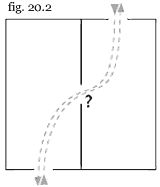 when
the normal route of entry cannot be clearly identified [fig.20.2, 20.3].
when
the normal route of entry cannot be clearly identified [fig.20.2, 20.3].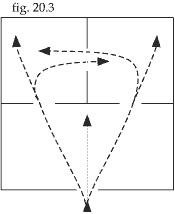 affixed
to the wooden door frame, even if it is not within 3.15 inches of the
outermost part of the doorpost. However, if there
affixed
to the wooden door frame, even if it is not within 3.15 inches of the
outermost part of the doorpost. However, if there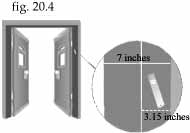 is
a wooden frame attached to the entryway exclusively for decoration and
it is not within 3.15 inches of the outermost part of the entry post,
the mezuzah should be affixed to the entry post.
is
a wooden frame attached to the entryway exclusively for decoration and
it is not within 3.15 inches of the outermost part of the entry post,
the mezuzah should be affixed to the entry post.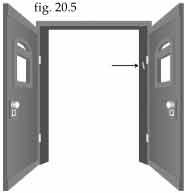 closes
on the front edge of the doorpost, then a niche should be made in the
doorpost to hold the mezuzah. If this is impractical, the mezuzah is affixed
to the doorpost behind the door, even if it is more than 3.15 inches
closes
on the front edge of the doorpost, then a niche should be made in the
doorpost to hold the mezuzah. If this is impractical, the mezuzah is affixed
to the doorpost behind the door, even if it is more than 3.15 inches 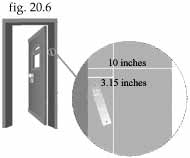 from
the outermost part of the entry post [fig 20.5]. However, if the door
opens inwards with its hinges on the right side so upon opening the door
the mezuzah is blocked from view or there is no post behind the door upon
which to affix the mezuzah, the mezuzah is affixed to the front of the
doorpost facing outward, within 3.15 inches of the doorpost [fig.20.6].
from
the outermost part of the entry post [fig 20.5]. However, if the door
opens inwards with its hinges on the right side so upon opening the door
the mezuzah is blocked from view or there is no post behind the door upon
which to affix the mezuzah, the mezuzah is affixed to the front of the
doorpost facing outward, within 3.15 inches of the doorpost [fig.20.6].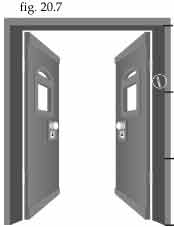 The
mezuzah is placed at the beginning of the upper third of the entry post
[fig.20.7], which is approximately shoulder height. The height is measured
from the floor to the bottom of the lintel. According to some poskim,
if the entrance is very high the mezuzah should be placed at shoulder
height, even if that will place it lower on the entry post than the lower
half of the upper third.
The
mezuzah is placed at the beginning of the upper third of the entry post
[fig.20.7], which is approximately shoulder height. The height is measured
from the floor to the bottom of the lintel. According to some poskim,
if the entrance is very high the mezuzah should be placed at shoulder
height, even if that will place it lower on the entry post than the lower
half of the upper third.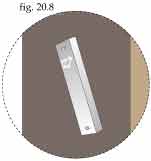 doorways of classrooms or children's bedrooms to enable the children to
kiss them.
doorways of classrooms or children's bedrooms to enable the children to
kiss them. 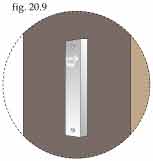
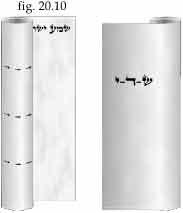 mezuzah
on a flat surface face up, with the word Shema (the first word)
in the top right corner and roll it starting from the left side [fig.20.10].
mezuzah
on a flat surface face up, with the word Shema (the first word)
in the top right corner and roll it starting from the left side [fig.20.10]. The
mezuzah must be firmly affixed to the doorpost so that it will not fall
off if it is lightly pushed, pulled, or bumped into. Therefore, one should
not use regular tape. Velcro or magnets may not be used to affix a mezuzah.
Strong glue or double-sided foam tape should only be used if the case
opens from the top or bottom. If the case opens from the back, and one
is using strong glue or foam tape, only the removable back of the cover
will be properly affixed to the doorpost, while the front, the main hollow
section containing the mezuzah, will not. Therefore, a case which opens
from the back should be affixed with nails or screws. Alternatively, the
front and back sections may be held together with a strong glue [fig.20.16].
The
mezuzah must be firmly affixed to the doorpost so that it will not fall
off if it is lightly pushed, pulled, or bumped into. Therefore, one should
not use regular tape. Velcro or magnets may not be used to affix a mezuzah.
Strong glue or double-sided foam tape should only be used if the case
opens from the top or bottom. If the case opens from the back, and one
is using strong glue or foam tape, only the removable back of the cover
will be properly affixed to the doorpost, while the front, the main hollow
section containing the mezuzah, will not. Therefore, a case which opens
from the back should be affixed with nails or screws. Alternatively, the
front and back sections may be held together with a strong glue [fig.20.16].
